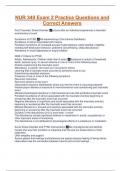Exam (elaborations)
NUR 340 Exam 2 Practice Questions and Correct Answers
- Course
- Institution
Post Traumatic Stress Disorder occurs after an individual experiences a traumatic event/series of event Symptoms of PTSD Re-experiencing of the trauma (flashback) Avoidance of stimuli associated with trauma Persistent symptoms of increased arousal (hypervigilance, easily startled, irritability, re...
[Show more]



